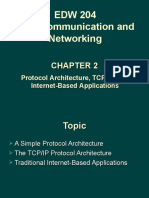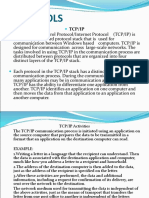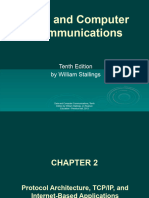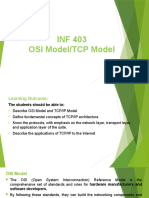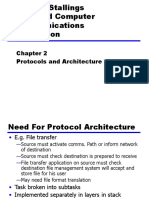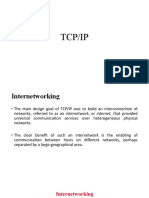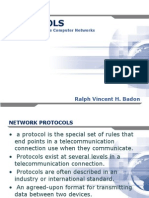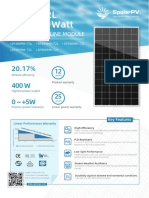Data and Computer Communications
Chapter 2 Protocol Architecture, TCP/IP, and Internet-Based Applications
�Protocol Architecture, TCP/IP, and Internet-Based Applications
To destroy communication completely, there
must be no rules in common between transmitter and receiverneither of alphabet nor of syntax On Human Communication, Colin Cherry
�Need For Protocol Architecture
data exchange can involve
complex procedures, cf. file transfer example better if task broken into subtasks implemented separately in layers in stack
each layer provides functions needed to perform communication for layers above using functions provided by layers below
peer layers communicate with a protocol
�Ke !lements o" a Protocol
syntax data block format semantics - control info. & error handling timing - speed matching & sequencing
�TCP/IP Protocol Architecture
developed by U
!efense "dvanced #esearch $ro%ect "gency &!"#$"' for "#$"()* packet switched network used by the global +nternet protocol suite comprises a large collection of standardi,ed protocols
�#impli"ied Net$or% Architecture
�TCP/IP &a ers
no official model but a working one
"pplication layer -ost-to-host, or transport layer +nternet layer (etwork access layer $hysical layer
�Ph sical &a er
concerned with
physical interface between computer and network concerned with issues like.
characteristics of transmission medium signal levels and nature data rates other related matters
�Net$or% Access &a er
exchange of data between an
and attached network concerned with issues like .
end system
destination address provision invoking specific services like priority access to & routing data across a network link between two attached systems
allows layers above to ignore link specifics
�Internet &a er 'IP(
routing functions
across multiple networks for systems attached to different networks using +$ protocol implemented in end systems and routers routers connect two networks and relays data between them
�Transport &a er 'TCP(
common layer shared by all applications provides
reliable delivery of data in same order as sent commonly uses */$
�Application &a er
provide
support for user applications need a separate module specific for each type of application
�)peration o" TCP and IP
�Addressin* +e,uirements
two levels
of addressing required each host on a subnet needs a unique global network address
its +$ address
each application on a &multi-tasking' host
needs a unique address within the host
known as a port
�)peration o" TCP/IP
�Transmission Control Protocol 'TCP(
usual transport layer is &*/$' provides a reliable connection for transfer of data between applications a */$ segment is the basic protocol unit */$ tracks segments between entities for duration of each connection
�TCP -eader
�.ser Data*ram Protocol '.DP(
an alternative to */$ no guaranteed delivery no preservation of sequence no protection against duplication minimum overhead 0ust adds port addressing to +$
�.DP -eader
�IP -eader
�IP/0 -eader
�TCP/IP Applications
have a number of standard */$1+$
applications such as
imple 2ail *ransfer $rotocol & 2*$' 3ile *ransfer $rotocol &3*$' control and data connections *elnet
�#ome TCP/IP Protocols
�)#I
4pen
ystems +nterconnection developed by the +nternational 4rgani,ation for tandardi,ation &+ 4' has seven layers too many is a theoretical system delivered too late5 */$1+$ is the de facto standard
�)#I &a ers
�)#I / TCP/IP
�#tandardi1ed Protocol Architectures
�&a er #peci"ic #tandards
�#er/ice Primiti/es and Parameters
define services
between ad%acent layers using. primitives to specify function performed parameters to pass data and control info
�Primiti/e T pes
REQUEST A primitive issued by a service user to invoke some service and to pass the parameters needed to specify fully the requested service A primitive issued by a service provider either to: indicate that a procedure has been invoked by the peer service user on the connection and to provide the associated parameters, or notify the service user of a provider-initiated action A primitive issued by a service user to acknowledge or complete some procedure previously invoked by an indication to that user A primitive issued by a service provider to acknowledge or complete some procedure previously invoked by a request by the service user INDICATION
RESPONSE
CONFIRM
�Traditional /s 2ultimedia Applications
traditionally +nternet dominated by info
retrieval applications
typically using text and image transfer ).g. email, file transfer, web
see increasing growth in multimedia
applications
involving massive amounts of data such as streaming audio and video
�!lastic and Inelastic Tra""ic
elastic traffic
can ad%ust to delay & throughput changes over a wide range ).g. traditional 6data7 style */$1+$ traffic some applications more sensitive though
inelastic
traffic
does not adapt to such changes ).g. 6real-time7 voice & video traffic need minimum requirements on net arch
�2ultimedia Ta3onom
�#ummar
introduced need for protocol architecture */$1+$ protocol architecture 4
+ 2odel & protocol architecture standardi,ation traditional vs multimedia application needs
�2C4
*he process to process delivery of the
entire message is the responsibility of the (etwork1*ransport1"pplication1$hysical layer. "s the data packet moves from the lower to the upper layers, headers are added1subtracted1rearranged1modified. 3ollowing is an application layer service. #emote log-in1file transfer1mail service1all of the above
�2C4
2atch the following with one of the five
internet layers. /ommunicates directly with user application program )rror correction and retransmission 2echanical, electrical, and functional interface #eassembly of data packets
�Pro5lems
89. +n a protocol suite, layer ( is above layer &(-9'. +n the case of segmentation, is it necessary that each &(-9' level segment contain a copy of the level (-header: ;hy: <locking means combining several level ( $!Us into one &(-9' level $!U. +n the case of blocking, is it necessary that each level- ( $!U retain its own header: ;hy:
�Pro5lems
8=. " */$ segment of 9>?? bit data and 9@? bit header is sent to the +$ layer. +$ layer adds 9@? bit header. +t is then transmitted through a network which uses =A-bit packet header. *he destination network can accept packet si,e of B?? bits. -ow many bits &including header' are delivered to the destination network layer:






